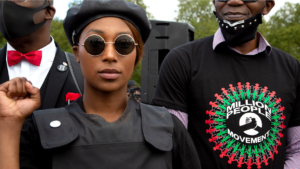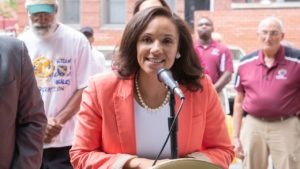Government officials took the only photos Florence Onus has of her grandparents — “mugshots” taken before they were forced off Country and onto an Aboriginal reserve.
WARNING: This story contains images of Indigenous people who have died, which have been provided by family for the purpose of truth-telling and healing. They request they should not be recorded or photographed.
With those portraits are reports from the 1930s which list their physical measurements, including the “thickness” of their lips and “nose breadth”, and whether they were “full-blood”, “half-caste” or “quarter-caste”.
The Bindal and Birrrigubba elder and activist keeps these “remnants” as evidence of people who survived the massacres, and “the rape, the brutalisation of our men, women and children”.
Ms Onus was the fourth generation of her family to be taken away by the state.
In 1938, her family was sent to a reserve at Woorabinda, inland from Rockhampton in central Queensland.
“I regard them as detention centres,” Ms Onus said.
Not long after they were forced from their country, her grandfather Arthur Fogarty was jailed for being an “agitator” at Woorabinda, where Ms Onus’s family were punished for contact with relatives and speaking language.
He died in custody in a fire at the watch house, which Ms Onus believes was arson.
A decade later, Ms Onus and her siblings were removed from their mother and sent to a Townsville orphanage before they were fostered out to a white woman, who they lived with into adolescence.
Her older sisters had already been sent to work as servants at a home for retired nuns.
“When I share my family history through truth-telling, people are quite shocked,” she said.
“I say that my story is not an isolated story. Very similar treatment happened to every Aboriginal family and person around the nation under the policies of protection, under the policies of assimilation.”
It’s this history Ms Onus will share at Queensland’s truth-telling inquiry when community sessions begin next month.
The truth-telling is part of the Queensland government’s Path to Treaty Act, which passed parliament with bipartisan support last year.
But Opposition Leader David Crisafulli has now withdrawn his backing after the majority of Australians rejected the Indigenous Voice to Parliament.
If the LNP wins government in October, Mr Crisafulli has pledged to roll back the Path to Treaty Act and stop the inquiry — which will by then be several months in.
“I am not going to create further division that we have seen through the referendum process. I don’t want to replicate that so I am being upfront with Queenslanders. I know not everyone will agree with that,” Mr Crisafulli said.
“I have a strong commitment to do good in Indigenous communities and that commitment remains as steadfast as ever.”
‘People want to live in denial’
Author, historian and long time Treaty advocate Dr Jackie Huggins described the LNP’s stance as “very unfortunate”.
“I think it will very much unite this state of ours once we have more information and education,” Dr Huggins said.
She urged Queenslanders who voted against the Voice to support the state’s Path to Treaty.
“Family violence, criminal justice, housing, education, employment, everything seems to be going backwards for our people,” she said.
“Unless we have structures in place … to bring about a change, I don’t think we will ever close the gap in our lifetimes, certainly not in my lifetime and perhaps the next few generations.”
Ms Onus fears the no vote is being used to discount Queensland’s Path to Treaty.
“I think people in Queensland feel that the no vote has given them a mandate to shut everything down, so there is already pushback on the treaty and pushback on truth-telling,” she said.
She said to stop the process would be a mistake.
“Australia missed the boat in not voting for us in regards to a Voice to Parliament. That was very disappointing. It hurt a lot of the young generation. They had all their hopes really dashed and as a result of that we’re still going through a lot of grieving,” she said.
“Our people haven’t even begun the healing journey of generational and intergenerational trauma.
“We just keep repeating ourselves, but no-one’s listening to us. For my generation, we’ve seen all our elders pass on and now we’re the elders and we’re saying we want action.”
Ms Onus said she hoped the inquiry’s recommendations wouldn’t just “sit on a shelf”.
“People want to live in denial. They don’t want to know the truth,” she said.
“We have to rewrite the narrative of this country because the current narrative is one big lie.”
Barrister Joshua Creamer, a Waanyi and Kalkadoon man, is chair of the Truth-Telling and Healing Inquiry.
“It’s a generational movement,” he said.
“It recognises that long, long past of advocating from Aboriginal and Torres Strait Islander people.
“It requires us to have both truth-telling sessions and truth-telling hearings and also to inspect, review and investigate documents and other materials held by the state.”
Those documents will look at the removal of children, wage theft, mission settlements, as well as other government policies and protecting acts.
A search for the truth
The inquiry will also hear from the Aboriginal and Torres Strait Islander people affected.
“I imagine there’ll be pretty harrowing accounts of how policies and procedures have impacted families and continue to impact people as well,” Mr Creamer said.
“At the other end you’ll hear a range of stories which shine a light on Aboriginal and Torres Strait Islander excellence and resilience.
“All inquiries are a search for the truth. That’s our role, that’s our overriding obligation, and that’s the work we’re going to undertake.”
If the LNP is elected and abandons the act, the inquiry will also end, Mr Creamer said.
“If the act doesn’t exist, the inquiry simply won’t exist either,” he said.
“Everybody who’s part of the inquiry, including the four other panel members, have signed on for a three-year term and we’ll continue in that role until advised otherwise.”
Truth-telling sessions begin next month and will travel around Queensland for a year.




